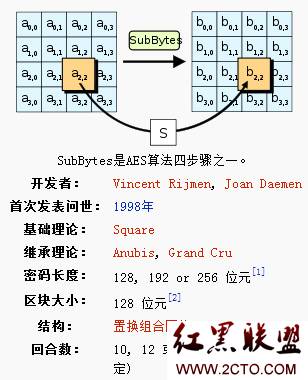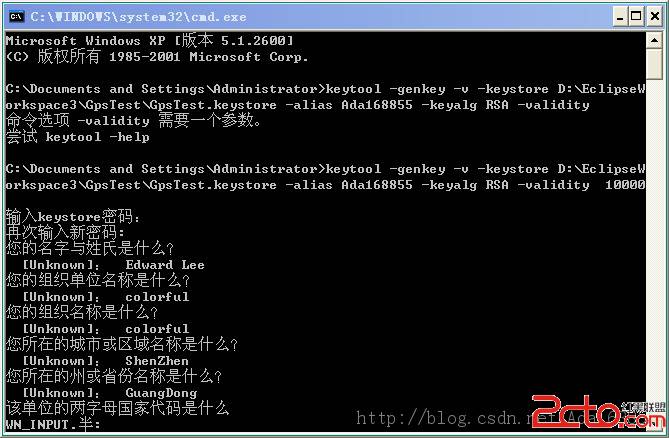实现android的AES加密技术
密码学中的高级加密标准(Advanced Encryption Standard,AES),又称Rijndael加密法,是美国联邦政府采用的一种区块加密标准。这个标准用来替代原先的DES,已经被多方分析且广为全世界所使用。经过五年的甄选流程,高级加密标准由美国国家标准与技术研究院 (NIST)于2001年11月26日发布于FIPS PUB 197,并在2002年5月26日成为有效的标准。2006年,高级加密标准已然成为对称密钥加密中最流行的算法之一。该算法为比利时密码学家Joan Daemen和Vincent Rijmen所设计,结合两位作者的名字,以Rijdael之命名之,投稿高级加密标准的甄选流程(Rijdael的发音近于 “Rhine doll”)。
AES 加密过程是在一个4×4的字节矩阵上运作,这个矩阵又称为“体(state)”,其初值就是一个明文区块(矩阵中一个元素大小就是明文区块中的一个 Byte)。(Rijndael加密法因支援更大的区块,其矩阵行数可视情况增加)加密时,各轮AES加密循环(除最后一轮外)均包含4个步骤:
1. AddRoundKey — 矩阵中的每一个字节都与该次循环的子密钥(round key)做XOR运算;每个子密钥由密钥生成方案产生。
2. SubBytes — 透过一个非线性的替换函数,用查找表的方式把每个字节替换成对应的字节。
3. ShiftRows — 将矩阵中的每个横列进行循环式移位。
4. MixColumns — 为了充分混合矩阵中各个直行的操作。这个步骤使用线性转换来混合每行内的四个字节。
最后一个加密循环中省略MixColumns步骤,而以另一个AddRoundKey取代。

Java代码
import java.security.SecureRandom;
import javax.crypto.Cipher;
import javax.crypto.KeyGenerator;
import javax.crypto.SecretKey;
import javax.crypto.spec.SecretKeySpec;
public class SimpleCrypto {
public static String encrypt(String seed, String cleartext) throws Exception {
byte[] rawKey = getRawKey(seed.getBytes());
byte[] result = encrypt(rawKey, cleartext.getBytes());
return toHex(result);
}
public static String decrypt(String seed, String encrypted) throws Exception {
byte[] rawKey = getRawKey(seed.getBytes());
byte[] enc = toByte(encrypted);
byte[] result = decrypt(rawKey, enc);
return new String(result);
}
private static byte[] getRawKey(byte[] seed) throws Exception {
KeyGenerator kgen = KeyGenerator.getInstance("AES");
SecureRandom sr = SecureRandom.getInstance("SHA1PRNG");
sr.setSeed(seed);
kgen.init(128, sr); // 192 and 256 bits may not be available
SecretKey skey = kgen.generateKey();
byte[] raw = skey.getEncoded();
return raw;
}
private static byte[] encrypt(byte[] raw, byte[] clear) throws Exception {
SecretKeySpec skeySpec = new SecretKeySpec(raw, "AES");
Cipher cipher = Cipher.getInstance("AES");
cipher.init(Cipher.ENCRYPT_MODE, skeySpec);
byte[] encrypted = cipher.doFinal(clear);
return encrypted;
}
private static byte[] decrypt(byte[] raw, byte[] encrypted) throws Exception {
SecretKeySpec skeySpec = new SecretKeySpec(raw, "AES");
Cipher cipher = Cipher.getInstance("AES");
cipher.init(Cipher.DECRYPT_MODE, skeySpec);
byte[] decrypted = cipher.doFinal(encrypted);
return decrypted;
}
public static String toHex(String txt) {
return toHex(txt.getBytes());
}
public static String fromHex(String hex) {
return new String(toByte(hex));
}
public static byte[] toByte(String hexString) {
int len = hexString.length()/2;
byte[] result = new byte[len];
for (int i = 0; i < len; i++)
result[i] = Integer.valueOf(hexString.substring(2*i, 2*i+2), 16).bytue();
return result;
}
public static String toHex(byte[] buf) {
if (buf == null)
return "";
StringBuffer result = new StringBuffer(2*buf.length);
for (int i = 0; i < buf.length; i++) {
appendHex(result, buf[i]);
}
return result.toString();
}
private final stati
补充:移动开发 , Android ,




